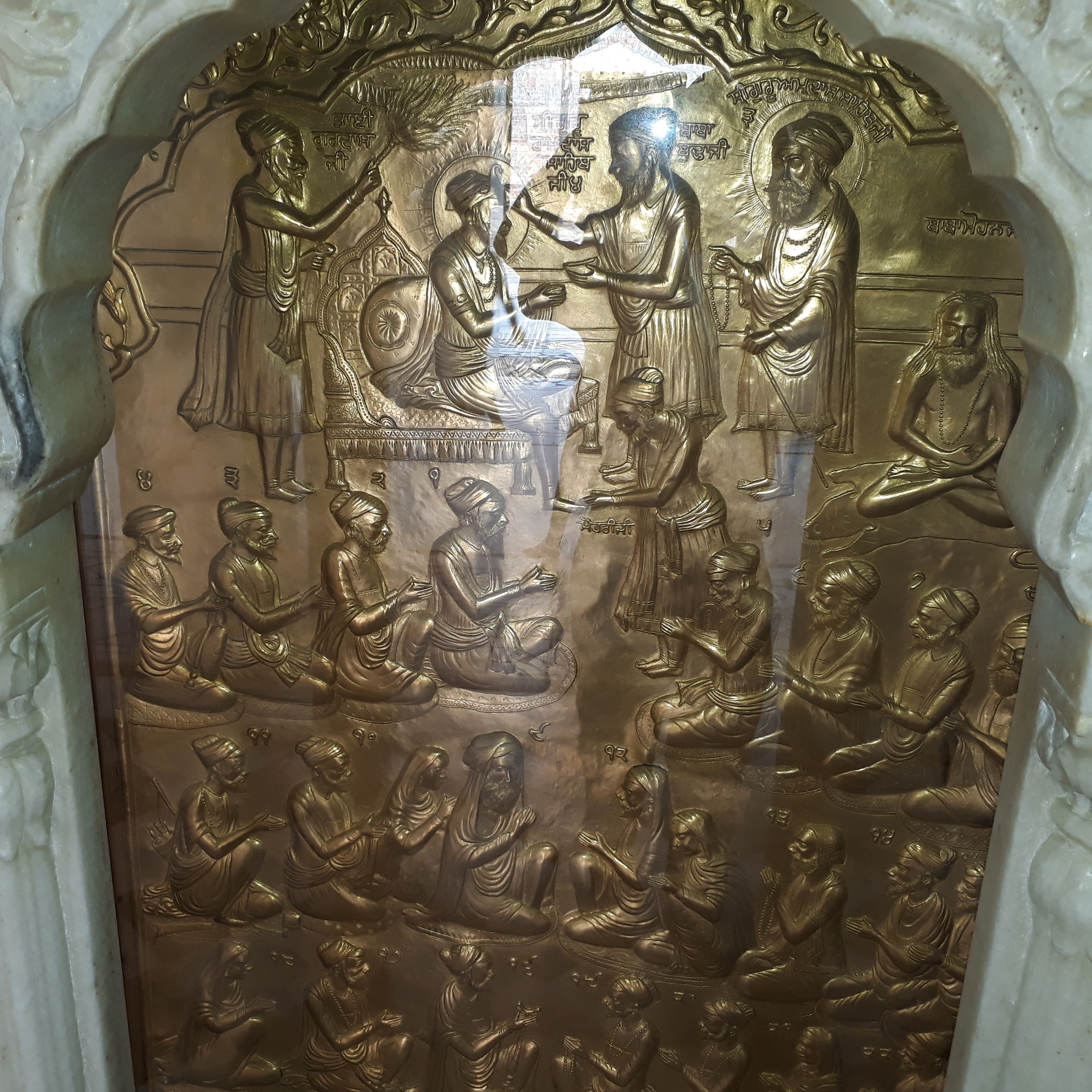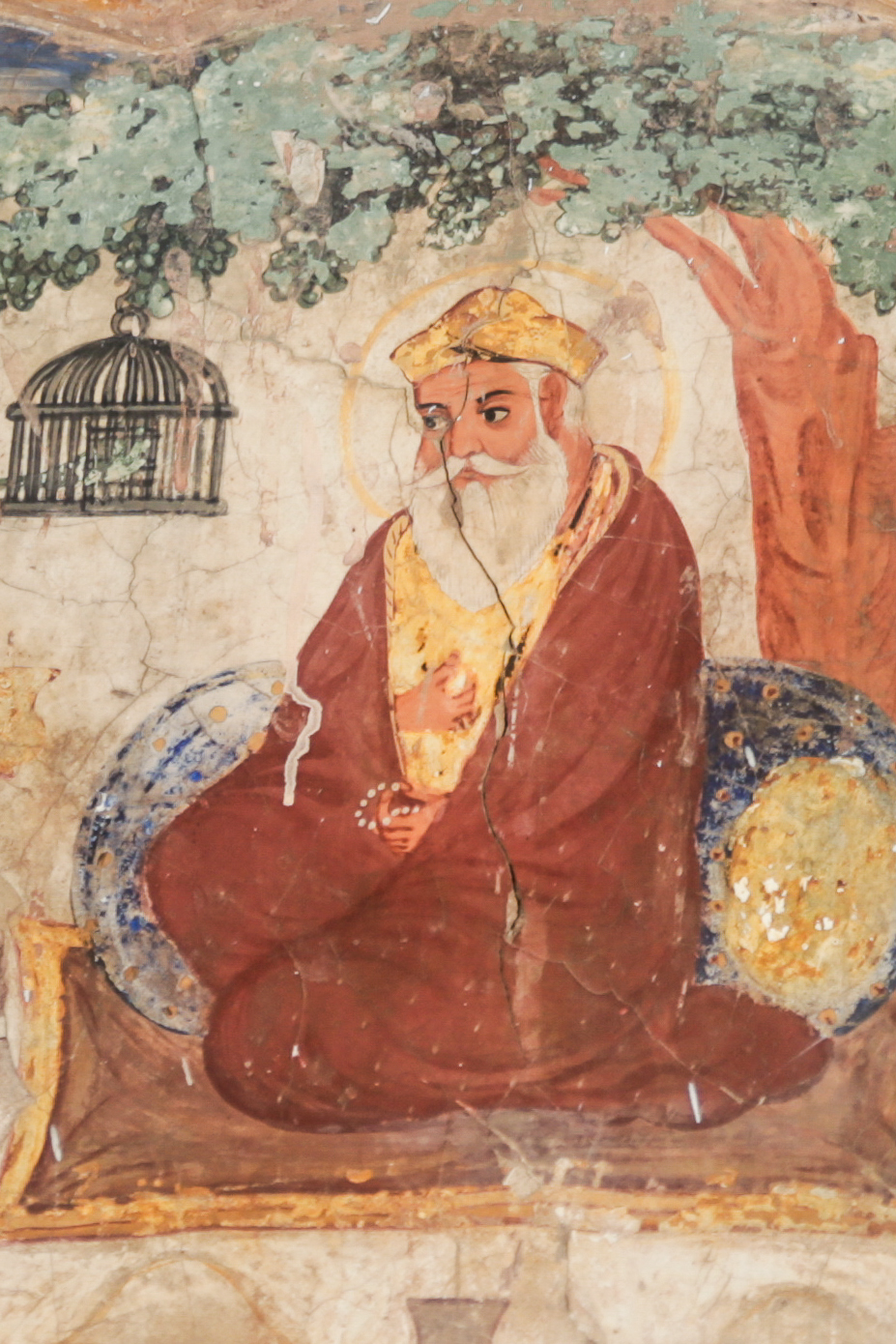|
Brahmin Sikhs
Brahmin Sikh is a Sikh religious group whose members belong to Brahmin community. They played a key role in the early years of Sikhism. Sometimes they are called Kashmiri Sikhs, for those who are of Kashmiri origin. History Brahmins from Punjab started to follow Sikhism since the birth of Guru Nanak. They mostly come from Saraswat, a sub sect of Brahmins, also called Sarsut in Punjabi, the rest come from the Gaur (Gaud) Brahmins. Population and distribution Mostly Brahmin Sikhs reside in India and UK. The majority of Brahmin Sikhs originate from Punjab, specifically from regions such as Patiala,Hoshiarpur, Gurdaspur, Bathinda, Chandigarh and Nawashahar. Additionally, a significant number have migrated and settled in Delhi. Some Brahmin Sikhs can trace their lineage to areas like Sialkot, and Lahore and Jammu and Kashmir. Contribution and influence on Sikhism Brahmins made exceptional contributions during the period of Sikh Gurus, demonstrating their remarkable abilitie ... [...More Info...] [...Related Items...] OR: [Wikipedia] [Google] [Baidu] |
Bhai Mati Das
Bhai Mati Das (Punjabi: ਭਾਈ ਮਤੀ ਦਾਸ; died 1675) along with his younger brother Bhai Sati Das were martyrs of early Sikh history. Bhai Mati Das, Bhai Dayala, and Bhai Sati Das were executed at a ''kotwali'' (police-station) in the Chandni Chowk area of Delhi, under the express orders of Emperor Aurangzeb just before the martyrdom of Guru Tegh Bahadur. Bhai Mati Das was executed by being bound between two pillars and cut in two. Biography Birth Bhai Mati Das belonged to a ( Saraswat) Mohyal Brahmin family of the Chhibber clan. He lived in the ancient village of Karyala, about ten kilometres from Chakwal on the road to the Katas Raj Temples in the Jhelum District in the Punjab region of Pakistan. Bhai Sati Das was his younger brother. Bhai Mati Das was the son of Hira Nand, a disciple of Guru Har Gobind, under whom he had fought in many battles and was a great warrior. Hira Nand was the grandson of Lakhi Das, the son of the Bhai Praga, who was also a martyr and had b ... [...More Info...] [...Related Items...] OR: [Wikipedia] [Google] [Baidu] |
Gurdaspur
Gurdaspur is a city in the Indian state of Punjab, between the rivers Beas and Ravi. It houses the administrative headquarters of Gurdaspur District and is in the geographical centre of the district, which shares a border with Pakistan. The Emperor Akbar was crowned at Kalanaur, which is 26 km from the city. History Mughal period Gurdaspur was founded by a '' dervish'' ('Muslim ascetic') named Bhai Chand. In April 1715, the Sikh revolutionary leader Banda Bahadur seized Gurdaspur from the Mughal forces of Farrukhsiyar (). Banda strengthened his defences, increased storage of supplies, and slashed the ''shahnahr'' canal. After an eight-month siege, the Mughal army of Abd al-Samad Khan broke into the Sikh garrison, arrested Banda and conquered Gurdaspur in December 1715. Demographics According to the 2011 India census, Gurdaspur had a population of 2,299,026 (1,212,995 males and 1,086,031 females). There was a 9.30% increase in population compared to that of 2 ... [...More Info...] [...Related Items...] OR: [Wikipedia] [Google] [Baidu] |
Bhatt Bhalh
Bhatt Bhalh was a Brahmin bard in the court of Guru Arjan, whose one hymn is present in Guru Granth Sahib, the holy book of Sikh Sikhs ( or ; pa, ਸਿੱਖ, ' ) are people who adhere to Sikhism (Sikhi), a monotheistic religion that originated in the late 15th century in the Punjab region of the Indian subcontinent, based on the revelation of Guru Nanak. The term ' ...s. : BHATT BANI References Sikh Bhagats {{Sikh-stub ...[...More Info...] [...Related Items...] OR: [Wikipedia] [Google] [Baidu] |
Bhatt Balh
Bhatt Balh was Brahmin bard in the court of Guru Arjan, whose five hymns are present in ''Guru Granth Sahib The Guru Granth Sahib ( pa, ਗੁਰੂ ਗ੍ਰੰਥ ਸਾਹਿਬ, ) is the central holy religious scripture of Sikhism, regarded by Sikhs as the final, sovereign and eternal Guru following the lineage of the ten human gurus of the rel ...'', the holy book of Sikhs. References Sikh Bhagats {{Sikh-stub ... [...More Info...] [...Related Items...] OR: [Wikipedia] [Google] [Baidu] |
Bhattan De Savaiye
Bhattan de Savaiye ( pa, ਭੱਟਾਂ ਦੇ ਸਵਈਏ; ''bhaṭāṁ dē sava'ī'ē''), also known as Bhatt Bani (Gurmukhi: ਭੱਟ ਬਾਣੀ; ''bhaṭa bāṇī''), is a name given to 123 Savaiyas composed by various Bhatts, which are present in Guru Granth Sahib, scripture of Sikhs. According to various scholars, these Savaiyas are eulogies of first five Gurus of Sikhism. Generally, it is accepted that there were 11 Bhatts whose hymns are present in Adi Granth, but controversy still exist that there are 12 or 17. Structure The savaiye starts from page 1389 from Savaiye Mahalla Pehla Ke and ends at page 1409 of Guru Granth Sahib. The savaiyas are under five titles: #Savaiya Mahalla Pehle Ke 1 ( pa, ਸਵਈਏ ਮਹਲੇ ਪਹਿਲੇ ਕੇ ੧) #Savaiye Mahalle Duje Ke 2 ( pa, ਸਵਈਏ ਮਹਲੇ ਦੂਜੇ ਕੇ ੨) #Savaiye Mahalle Teeje Ke 3 ( pa, ਸਵਈਏ ਮਹਲੇ ਤੀਜੇ ਕੇ ੩) #Savaiye Mahalle Chauthe Ke 4 ( pa, ਸਵਈਏ ... [...More Info...] [...Related Items...] OR: [Wikipedia] [Google] [Baidu] |
Manji (Sikhism)
A Manji (Punjabi: ਮੰਜੀ ਪ੍ਰਥਾ ) was a Sikh religious administrative unit for the propagation of Sikhism towards men. It was part of the Sikh missionary administrative organization founded by Guru Amar Das, the third Guru of Sikhism. Manji refers to each zone of religious administration with an appointed chief called ''sangatias'', with officially appointed representatives known as a ''masand''. It had been conceptually similar in its aims to the diocese system in Christianity, and had been similarly important in Sikh missionary activity. The word ''Manji'' or ''Manja'' literally means a cot (taken as the ''seat of authority'' in this context). A similar administrative unit existed for women. It was known as a Piri and was part of the Piri system. Guru Amar Das divided the Sikh congregation areas into twenty-two Manjis. He appointed a local preacher to be in-charge of each of the Manjis. For this purpose, a large group of 146 followers were trained for the prop ... [...More Info...] [...Related Items...] OR: [Wikipedia] [Google] [Baidu] |
Writers Of The Guru Granth Sahib
Shri Guru Granth Sahib Ji ( pa, ਸ਼੍ਰੀ ਗੁਰੂ ਗ੍ਰੰਥ ਸਾਹਿਬ ਜੀ; ), is the central religious text of Sikhism, considered by Sikhs to be the final sovereign Guru of the religion. It contains 1430 ''Angs'' (limbs), containing 5,894 hymns of 36 saint mystics which includes Sikh guru sahiban (6 gurus), ''Bhagats'' (15 '' bhagats''), ''Bhatts'' (11 '' bhatts'') and ''gursikhs'' (4 ''gursikhs''). It is notable among foundational religious scriptures for including hymns from writers of other religions, namely Hindus and Muslims. It also contains teachings of Sikh gurus themselves. Categorization of authors Scholars categorize the authors of the Guru Granth Sahib into four groups: # Sikh Gurus # Bhagats # Bhatts # Gursikhs Sikh gurus Philosophically, Sikhs are bound to believe in ''Shabad Guru'' — the words written in the Guru Granth Sāhib ji — but the general belief is that the Sikh Gurus established Sikhism over the centuries, beginning ... [...More Info...] [...Related Items...] OR: [Wikipedia] [Google] [Baidu] |
Guru Granth Sahib
The Guru Granth Sahib ( pa, ਗੁਰੂ ਗ੍ਰੰਥ ਸਾਹਿਬ, ) is the central holy religious scripture of Sikhism, regarded by Sikhs as the final, sovereign and eternal Guru following the lineage of the ten human gurus of the religion. The Adi Granth ( pa, ਆਦਿ ਗ੍ਰੰਥ), its first rendition, was compiled by the fifth guru, Guru Arjan (1564–1606). Its compilation was completed on 29 August 1604 and first installed inside Golden Temple in Amritsar on 1 September 1604. Baba Buddha was appointed the first Granthi of the Golden Temple. Shortly afterwards Guru Hargobind added Ramkali Ki Vaar. Later, Guru Gobind Singh, the tenth Sikh guru, added hymns of Guru Tegh Bahadur to the Adi Granth and affirmed the text as his successor. This second rendition became known as the Guru Granth Sahib and is also sometimes referred to as the Adi Granth. [...More Info...] [...Related Items...] OR: [Wikipedia] [Google] [Baidu] |
Sikh Gurus
The Sikh gurus (Punjabi: ਸਿੱਖ ਗੁਰੂ) are the spiritual masters of Sikhism, who established this religion over the course of about two and a half centuries, beginning in 1469. The year 1469 marks the birth of Guru Nanak, the founder of Sikhism. He was succeeded by nine other human gurus until, in 1708, the '' Guruship'' was finally passed on by the tenth guru to the holy Sikh scripture, Guru Granth Sahib, which is now considered the living Guru by the followers of the Sikh faith. Etymology and definition ''Guru'' (, ; sa, गुरु, Punjabi: ਗੁਰੂ, IAST: ''guru'') is a Sanskrit term for a "teacher, guide, expert, or master" of certain knowledge or field. Bhai Vir Singh, in his dictionary of Guru Granth Sahib describes the term Guru as a combination of two separate units: "Gu;(ਗੁ)" meaning darkness and "Rū;(ਰੂ)" which means light. Hence, Guru is who brings light into darkness or in other words, the one who enlightens. Bhai Vir Singh's defi ... [...More Info...] [...Related Items...] OR: [Wikipedia] [Google] [Baidu] |
Jammu And Kashmir (union Territory)
Jammu and Kashmir is a region administered by India as a union territory and consists of the southern portion of the larger Kashmir region, which has been the subject of a dispute between India and Pakistan since 1947, and between India and China since 1962.(a) (subscription required) Quote: "Kashmir, region of the northwestern Indian subcontinent ... has been the subject of dispute between India and Pakistan since the partition of the Indian subcontinent in 1947. The northern and western portions are administered by Pakistan and comprise three areas: Azad Kashmir, Gilgit, and Baltistan, the last two being part of a territory called the Northern Areas. Administered by India are the southern and southeastern portions, which constitute the state of Jammu and Kashmir but are slated to be split into two union territories. China became active in the eastern area of Kashmir in the 1950s and has controlled the northeastern part of Ladakh (the easternmost portion of the region) sinc ... [...More Info...] [...Related Items...] OR: [Wikipedia] [Google] [Baidu] |
Lahore
Lahore ( ; pnb, ; ur, ) is the second most populous city in Pakistan after Karachi and 26th most populous city in the world, with a population of over 13 million. It is the capital of the province of Punjab where it is the largest city. Lahore is one of Pakistan's major industrial and economic hubs, with an estimated GDP ( PPP) of $84 billion as of 2019. It is the largest city as well as the historic capital and cultural centre of the wider Punjab region,Lahore Cantonment globalsecurity.org and is one of Pakistan's most socially liberal, |
Sialkot
Sialkot ( ur, ) is a city located in Punjab, Pakistan. It is the capital of Sialkot District and the 13th most populous city in Pakistan. The boundaries of Sialkot are joined with Jammu (the winter capital of Indian administered Jammu and Kashmir) in the north east, the districts of Narowal in the southeast, Gujranwala in the southwest and Gujrat in the northwest. Sialkot is believed to be the successor of ancient Sagala, the capital of the Madra kingdom razed by Alexander the Great in 326 BCE, and then made capital of the Indo-Greek kingdom by Menander I in the 2nd century BCE—a time during which the city greatly prospered as a major center for trade and Buddhist thought. In 6th century, it was again made capital of the Taank Kingdom, which ruled Punjab for the next two centuries. Sialkot continued to be a major political centre until it was eclipsed by Lahore around the turn of the first millennium. The city rose again in prominence during the British era and is now one ... [...More Info...] [...Related Items...] OR: [Wikipedia] [Google] [Baidu] |






